INSTITUT SUPERIEUR D'ANTHROPOLOGIE
INSTITUTE OF ANTHROPOLOGY
ONLINE COURSES / COURS A DISTANCE
WINTER TERM : JANUARY 2015
REGISTER NOW
LIBAN – 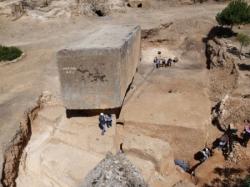 Baalbek - In the summer of 2014 the Oriental Department of the German Archaeological Institute conducted excavations in the stone quarry of Baalbek/Ancient Heliopolis, in Lebanon. There lies the monolith “Hajjar al-Hibla” (Stone of the Pregnant Woman). Similar stone blocks of a 20m-length were used for the podium of the huge Temple of Jupiter in the Roman sanctuary of Baalbek. The aim of this year’s excavations was to find new data about the mining techniques and the transporting of the megaliths. Archaeologists documented processing traces and investigated the old dumps of the mining activities, in order to locate datable and stratifiable sherds of pottery and small finds. Archaeologists found out that the monolith “Hajjar al-Hibla” was left in the quarry, because the stone quality of a block’s edge proved to be poor and the monolith could easily be damaged during its transport. Below the “Hajjar al-Hibla” and directly beside of it, there is another megalithic stone block, even bigger than the first one: it measures ca. 19,60x6x5,5m. In order to determine the exact height, the trenches should be extended in one of the next archaeological expeditions at the site. The second block weighs 1,650 tons. Archaeologists concluded that the block was meant to be transported without being cut. This means, that it is the biggest known ancient stone block.
Baalbek - In the summer of 2014 the Oriental Department of the German Archaeological Institute conducted excavations in the stone quarry of Baalbek/Ancient Heliopolis, in Lebanon. There lies the monolith “Hajjar al-Hibla” (Stone of the Pregnant Woman). Similar stone blocks of a 20m-length were used for the podium of the huge Temple of Jupiter in the Roman sanctuary of Baalbek. The aim of this year’s excavations was to find new data about the mining techniques and the transporting of the megaliths. Archaeologists documented processing traces and investigated the old dumps of the mining activities, in order to locate datable and stratifiable sherds of pottery and small finds. Archaeologists found out that the monolith “Hajjar al-Hibla” was left in the quarry, because the stone quality of a block’s edge proved to be poor and the monolith could easily be damaged during its transport. Below the “Hajjar al-Hibla” and directly beside of it, there is another megalithic stone block, even bigger than the first one: it measures ca. 19,60x6x5,5m. In order to determine the exact height, the trenches should be extended in one of the next archaeological expeditions at the site. The second block weighs 1,650 tons. Archaeologists concluded that the block was meant to be transported without being cut. This means, that it is the biggest known ancient stone block.
http://www.archaeology.wiki/blog/2014/11/24/biggest-ancient-stone-block-baalbekancient-heliopolis/
DANEMARK – 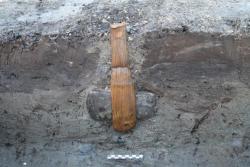 Femern Belt - Archaeologists from Museum Lolland-Falster have found a remarkably well-preserved axe with an intact shaft during their digs in connection with the construction of the Femern Belt Fixed Link. The narrow-necked flint axe is evaluated to be about 5,500 years old and was found in what used to be the seabed during the Stone Age. ”To find such a well-preserved shafted axe is incredible,” Søren Anker Sørensen, an archaeologist with Museum Lolland-Falster, said in a press release. "Thanks to the unique preservation conditions, we have found a lot of organic material during the digs. We had also found several special items such as an oar, two bows and 14 axe shafts, but when we found an entire shafted axe 30cm below the sea floor, we knew we had made a unique find.” Axes were an important tool in the Stone Age for wood-work purposes. They played a significant role in the introduction of agriculture at a time when most of the land was covered by forest, which needed to be cleared. The archaeologists maintain that the dig area just east of Rødbyhavn must have had a ritual significance because the axe and other found items were purposely placed into the earth standing up vertically.
Femern Belt - Archaeologists from Museum Lolland-Falster have found a remarkably well-preserved axe with an intact shaft during their digs in connection with the construction of the Femern Belt Fixed Link. The narrow-necked flint axe is evaluated to be about 5,500 years old and was found in what used to be the seabed during the Stone Age. ”To find such a well-preserved shafted axe is incredible,” Søren Anker Sørensen, an archaeologist with Museum Lolland-Falster, said in a press release. "Thanks to the unique preservation conditions, we have found a lot of organic material during the digs. We had also found several special items such as an oar, two bows and 14 axe shafts, but when we found an entire shafted axe 30cm below the sea floor, we knew we had made a unique find.” Axes were an important tool in the Stone Age for wood-work purposes. They played a significant role in the introduction of agriculture at a time when most of the land was covered by forest, which needed to be cleared. The archaeologists maintain that the dig area just east of Rødbyhavn must have had a ritual significance because the axe and other found items were purposely placed into the earth standing up vertically.
http://cphpost.dk/news/archaeologists-unearth-ancient-flint-axe-near-roedbyhavn.11756.html?
FRANCE –  Haute-Avesne - Le lieu du futur chantier de mise à deux fois deux voies de la D 939 entre Étrun et Aubigny-en-Artois, à l’ouest d’Arras, a été investi préalablement par les archéologues du conseil général. Des découvertes intéressantes pourraient conduite à des fouilles plus approfondies.La phase de diagnostic archéologique menée en septembre et jusqu’à fin octobre entre Étrun et Aubigny-en-Artois a consisté à observer environ 10 % de la surface du futur chantier. On creuse des tranchées de 50 cm de profondeur sur 2 mètres de large de part et d’autres de la route existante, sur l’emprise du futur tracé à deux fois deux voies. On fouille la terre végétale, puis on rebouche en attendant de savoir si l’État prescrira des recherches complémentaires, selon l’intérêt de ce qui a été découvert.Il est « possible » que des fouilles supplémentaires soient décidées à Haute-Avesnes où les archéologues ont dégagé « des traces d’une occupation gauloise : des restes d’habitat (petite ferme, grenier) ainsi qu’une tombe funéraire » qui semblent intéressants. Ils ont aussi trouvé des traces de cantonnements arrières britaniques de la Grande Guerre (boites decorned beef, bouteilles en verre,...).
Haute-Avesne - Le lieu du futur chantier de mise à deux fois deux voies de la D 939 entre Étrun et Aubigny-en-Artois, à l’ouest d’Arras, a été investi préalablement par les archéologues du conseil général. Des découvertes intéressantes pourraient conduite à des fouilles plus approfondies.La phase de diagnostic archéologique menée en septembre et jusqu’à fin octobre entre Étrun et Aubigny-en-Artois a consisté à observer environ 10 % de la surface du futur chantier. On creuse des tranchées de 50 cm de profondeur sur 2 mètres de large de part et d’autres de la route existante, sur l’emprise du futur tracé à deux fois deux voies. On fouille la terre végétale, puis on rebouche en attendant de savoir si l’État prescrira des recherches complémentaires, selon l’intérêt de ce qui a été découvert.Il est « possible » que des fouilles supplémentaires soient décidées à Haute-Avesnes où les archéologues ont dégagé « des traces d’une occupation gauloise : des restes d’habitat (petite ferme, grenier) ainsi qu’une tombe funéraire » qui semblent intéressants. Ils ont aussi trouvé des traces de cantonnements arrières britaniques de la Grande Guerre (boites decorned beef, bouteilles en verre,...).
http://www.lavoixdunord.fr/region/haute-avesnes-des-fouilles-archeologiques-ont-mis-a-ia29b6427n2503493
ROYAUME UNI – 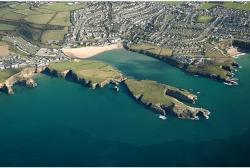
 Newquay- A coastal survey is taking place at Trevelgue Head – the site of an important cliff castle – on Porth Island, Newquay, to assess erosion on the site from both visitors and storm damage. The survey will provide a comprehensive record of the current areas of erosion, which can be monitored in the future and will enable plans to be made on how to deal with the eroded areas. Trevelgue Head is an impressive Iron Age promontory cliff castle, defined by a spectacular series of large earth and stone ramparts, which defended an east-west headland 700m long and protecting, on its south side, the excellent natural harbour of St Columb Porth. Two Bronze Age barrows survive on the headland, along with the remains of an extensive late Iron Age and Romano British settlement. It is designated by English Heritage as a Scheduled Monument. Cornwall Council senior archaeologist Ann Reynolds said: "It is one of the most heavily defended headlands in Cornwall but as a result of natural erosion and visitor pressure it is probably also one of the most heavily denuded. Last winter's storms have also caused significant areas of erosion and minor landslips, exposing fragile archaeological layers and features."
Newquay- A coastal survey is taking place at Trevelgue Head – the site of an important cliff castle – on Porth Island, Newquay, to assess erosion on the site from both visitors and storm damage. The survey will provide a comprehensive record of the current areas of erosion, which can be monitored in the future and will enable plans to be made on how to deal with the eroded areas. Trevelgue Head is an impressive Iron Age promontory cliff castle, defined by a spectacular series of large earth and stone ramparts, which defended an east-west headland 700m long and protecting, on its south side, the excellent natural harbour of St Columb Porth. Two Bronze Age barrows survive on the headland, along with the remains of an extensive late Iron Age and Romano British settlement. It is designated by English Heritage as a Scheduled Monument. Cornwall Council senior archaeologist Ann Reynolds said: "It is one of the most heavily defended headlands in Cornwall but as a result of natural erosion and visitor pressure it is probably also one of the most heavily denuded. Last winter's storms have also caused significant areas of erosion and minor landslips, exposing fragile archaeological layers and features."
http://www.cornishguardian.co.uk/Newquay-coastal-survey-help-monitor-erosion/story-24551924-detail/story.html
INDE – 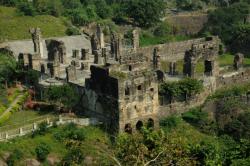 Kondapalli - After much dilly-dallying, the Department of Archaeology and Museums has finally begun chemical conservation treatment to the historic Kondapalli Fort to lend an aesthetic look to it. The ‘gajasala’, ‘narthakasala’, arches, meeting hall and the front portion of the fort will be covered under the first phase of works which are expected to be completed in a fortnight. A 25-member team led by the Archaeology Department Assistant Chemist K. Rambabu are taking up the works at a cost of over Rs.7.5 lakh. “We are using natural ingredients to prevent damage to the stone-structured citadel. We are carrying out the chemical treatment works, lacing chemicals with water to give a new look to the citadel. Scaffoldings were put up to cover every nook and corner of the fort,” he said. The fort was built by Prolaya Vema Reddy in the 14th century. Shrubs that were developed on the fort walls were removed using iron and brass brushes before commencing the chemical treatment works. “We want to give an aesthetic look to the fort to draw the attention of tourists,” he said. The dilapidated structure, which is included in the mega tourism circuit proposed to be developed in this region, is 16 km from Vijayawada.
Kondapalli - After much dilly-dallying, the Department of Archaeology and Museums has finally begun chemical conservation treatment to the historic Kondapalli Fort to lend an aesthetic look to it. The ‘gajasala’, ‘narthakasala’, arches, meeting hall and the front portion of the fort will be covered under the first phase of works which are expected to be completed in a fortnight. A 25-member team led by the Archaeology Department Assistant Chemist K. Rambabu are taking up the works at a cost of over Rs.7.5 lakh. “We are using natural ingredients to prevent damage to the stone-structured citadel. We are carrying out the chemical treatment works, lacing chemicals with water to give a new look to the citadel. Scaffoldings were put up to cover every nook and corner of the fort,” he said. The fort was built by Prolaya Vema Reddy in the 14th century. Shrubs that were developed on the fort walls were removed using iron and brass brushes before commencing the chemical treatment works. “We want to give an aesthetic look to the fort to draw the attention of tourists,” he said. The dilapidated structure, which is included in the mega tourism circuit proposed to be developed in this region, is 16 km from Vijayawada.
http://www.thehindu.com/news/national/andhra-pradesh/chemical-conservation-treatment-to-kondapalli-fort-begins/article6629830.ece
TURQUIE –  Istanbul -A historical Ottoman carpet has been restored by a team of 10 in the Central Anatolian province of Aksaray’s Sultanhanı district, considered the world’s largest carpet restoration center. The restoration of the 120-square-meter Hereke carpet went on for 18 months.
Istanbul -A historical Ottoman carpet has been restored by a team of 10 in the Central Anatolian province of Aksaray’s Sultanhanı district, considered the world’s largest carpet restoration center. The restoration of the 120-square-meter Hereke carpet went on for 18 months.
Sultanhanı Mayor Fahri Solak said the restoration of the 19th-century carpet had been made in the ateliers in the district.“The carpet was in the care of the Istanbul Governor’s Office. During the restoration of the Governor’s Office building, a painting was found by the governor at the time, Hüseyin Avni Mutlu. The painting featured the table, fireplace and a carpet in the building. The table and fireplace still existed there but the carpet was lost. Then it turned out that the carpet was given to the Dolmabahçe Palace 20 years ago and kept in a depot. Mutlu took out the carpet and got in touch with us for its restoration,” Solak said. The largest carpet in Turkey is a 400-square-meter Hereke carpet currently at Yıldız Palace in Istanbul, but the one restored in Aksaray could be one of the country's five largest.
http://www.hurriyetdailynews.com/mammoth-ottoman-carpet-restored.aspx?pageID=238&nID=74760&NewsCatID=375
USA – 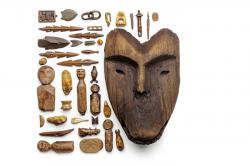 Quinhaga - Enfouis sous les glaces alaskiennes, les vestiges d’un ancien village inuit menacent d’être entrainés vers le large de la mer de Béring en raison des effets du réchauffement climatique. Sur place, les archéologues se démènent pour récupérer ce qui peut l’être. Situé à 650 km à l’ouest d’Anchorage, ce site inuit était occupé par des Yu’pits entre 1300 et 1650. Des fouilles d’urgences, entreprises dès 2009, ont déjà permis de récupérer environ 20 000 objets jadis emprisonnés dans le pergélisol. Les exemples montrés ci-dessus incluent un masque cérémoniel grandeur nature en bois, des poupées sculptées dans du bois flotté, des pointes de harpon en ramure de caribou, des pointes de flèche en ardoise et deux bagues entrelacées en ivoire de morse. Le chef archéologique Rick Knecht estime que le déblayage nécessitera encore cinq ans de travail, le risque étant qu’une tempête hivernale emporte ce qui reste.
Quinhaga - Enfouis sous les glaces alaskiennes, les vestiges d’un ancien village inuit menacent d’être entrainés vers le large de la mer de Béring en raison des effets du réchauffement climatique. Sur place, les archéologues se démènent pour récupérer ce qui peut l’être. Situé à 650 km à l’ouest d’Anchorage, ce site inuit était occupé par des Yu’pits entre 1300 et 1650. Des fouilles d’urgences, entreprises dès 2009, ont déjà permis de récupérer environ 20 000 objets jadis emprisonnés dans le pergélisol. Les exemples montrés ci-dessus incluent un masque cérémoniel grandeur nature en bois, des poupées sculptées dans du bois flotté, des pointes de harpon en ramure de caribou, des pointes de flèche en ardoise et deux bagues entrelacées en ivoire de morse. Le chef archéologique Rick Knecht estime que le déblayage nécessitera encore cinq ans de travail, le risque étant qu’une tempête hivernale emporte ce qui reste.
http://www.nationalgeographic.fr/13739-alask-inuits-sauves-des-eaux/
USA –Swanton - A University of Vermont team of archeologists excavating a cornfield in Swanton in preparation for a water main has found pottery, buttons and other items going back hundreds of years. The St. Albans Messenger reports the team, which dug about 4 feet deep, has found evidence of three long-term occupations of the land between 500 A.D. and 1600 A.D. The site is on the Missiquoi River flood plain. They believe that in the 1800s, the site was the home of a Revolutionary War soldier. Kate Kenney, a program historian, says a piece of metal found might have been part of a bridle.
http://www.wptz.com/news/artifacts-discovered-in-champlain-valley/29898802?absolute=true